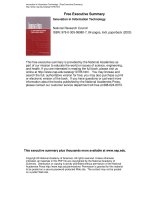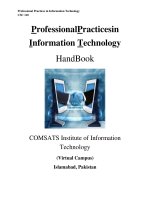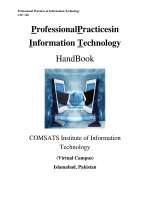Lecture Note Professional practices in information technology - Lecture No. 19: Introduction to Hacking
Bạn đang xem bản rút gọn của tài liệu. Xem và tải ngay bản đầy đủ của tài liệu tại đây (363.05 KB, 5 trang )
Professional Practices in Information Technology
CSC 110
ProfessionalPracticesin
Information Technology
HandBook
COMSATS Institute of Information
Technology
(Virtual Campus)
Islamabad, Pakistan
Professional Practices in Information Technology
CSC 110
Lecture 19
Introduction to Hacking
19.1 What Is Network Security?
Security is much larger than just packets, firewalls, and hackers. Security includes:
– Policies and procedures
– Liabilities and laws
– Human behavior patterns
– Corporate security programs and implementation
– Technical aspects firewalls, intrusion detection systems, proxies, encryption, antivirus
software, hacks, cracks, and attacks
Understanding hacking tools and how attacks are carried out is only one piece of the puzzle.
Attacks
There are many types of attacks
– Spoofing attack
– Telnet based attack
– DOS (Daniel of service) attack
– Ping of death
Professional Practices in Information Technology
CSC 110
– Distributed dos attack
– Mailbombs
Need For Security
Some excellent software can provide you best security, like:
– Trojan
– Firewall
Trojan
Windows Trojans are small aspect of windows security. Trojan is unauthorized program
contained within a legitimate program. This program performs function unknown by user.
Firewall
Firewall is any device used to prevent outsiders from gaining access to your network. Types of
firewalls are:
– Packet filter
– Application proxy
– Packet inspection
19.2 Common Steps for Attackers
Reconnaissance
– Intelligent work of obtaining information either actively or passively
Professional Practices in Information Technology
CSC 110
– Examples:
•
Passively: Sniffing Traffic, eavesdropping
•
Actively: Obtaining data from American Registry for Internet Numbers (ARIN), whois
databases, web sites, social engineering
Scanning
– Identifying systems that are running and services that are active on them
– Examples: Ping sweeps and port scans
Gaining Access
– Exploiting identified vulnerabilities to gain unauthorized access
– Examples: Exploiting a buffer overflow or brute forcing a password and logging onto a
system
Maintaining Access
– Uploading malicious software to ensure reentry is possible
– Example: Installing a backdoor on a system
Covering Tracks
– Carrying out activities to hide one’s malicious activities
– Example: Deleting or modifying data in a system and its application logs
19.3 Where do Attackers get the Most Traction?
Professional Practices in Information Technology
CSC 110
Flaws within software are the root of the problem of successful attacks and exploits. Security
does not like complexity. The more complex software gets, the harder it is to properly predict
how it will react in all possible scenarios thus making it much harder to secure. Windows XP is
approximately 40 million lines of code. Linux is approximately 2 million lines of code. Estimate
in industry: 5 to 10 bugs per 1,000 lines of code => Windows XP has approximately 200,000
bugs.
With objectoriented language applications and operating systems using each other’s code, DLLs
are installed and shared, many applications communicate with each other => Operating Systems
cannot control this flow and provide protection against possible compromises
Enough Blame to Go Around
Software vendors do not consider security in the design and specification phases. Programmers
have not been properly taught how to code securely. Vendors are not held liable for faulty code.
Consumers are not willing to pay more for properly developed and tested code.
Novice versus Advanced
Novice ethical hacker will use tools/techniques developed by others. A more advanced ethical
hacker will not only depend upon other people’s tools but will have the skill set and
understanding to develop their own tools/techniques.









